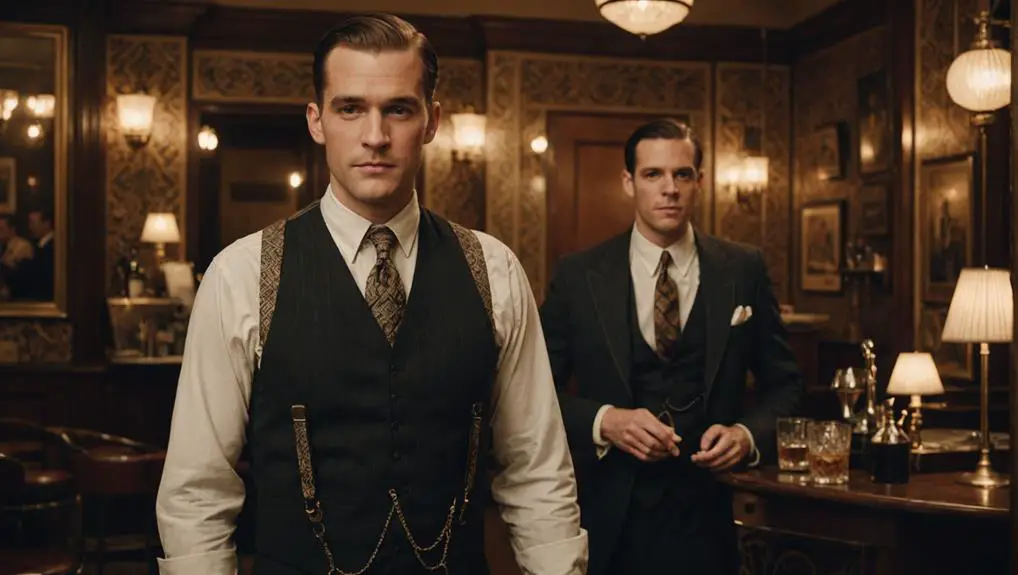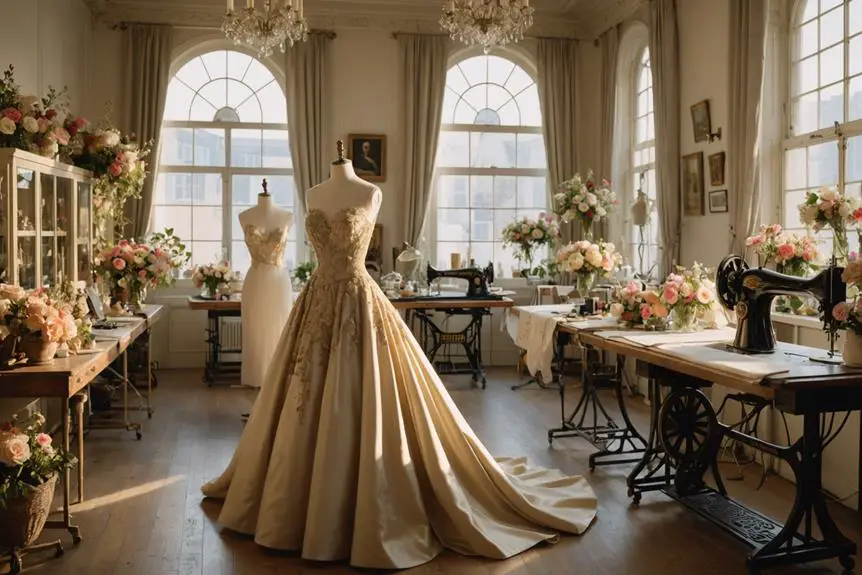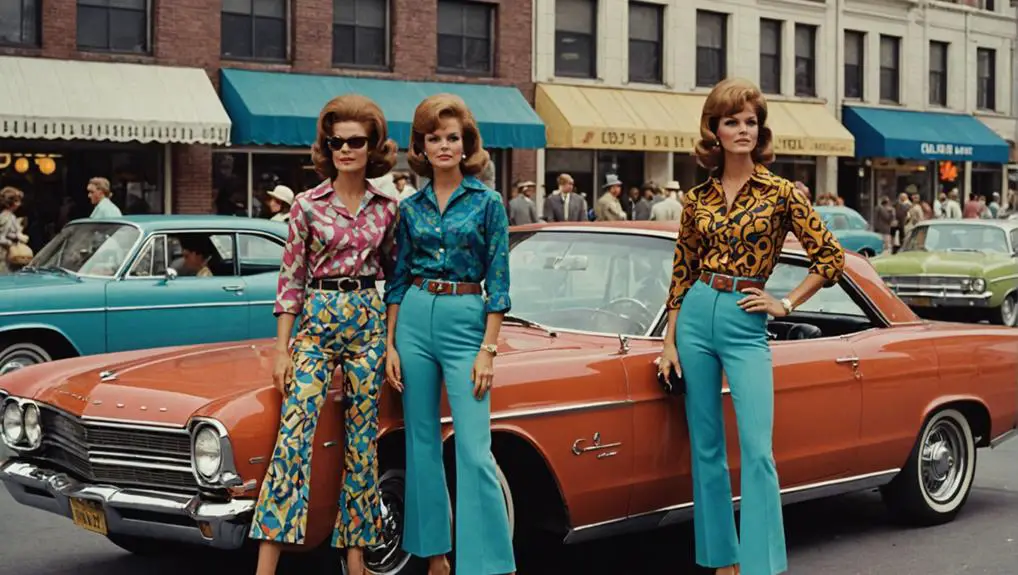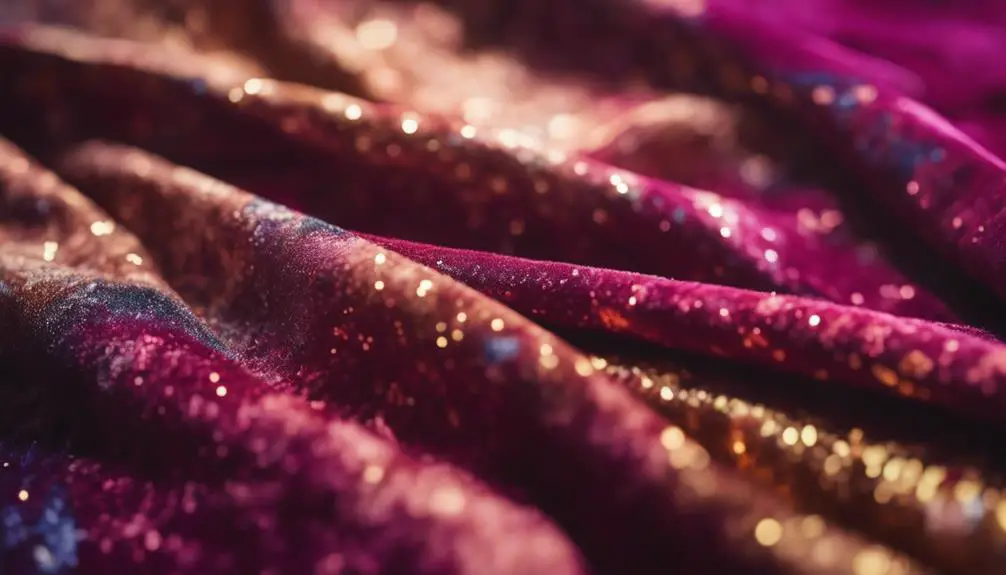In the 1920s, men's suspenders, or braces, became essential fashion accessories, striking a perfect balance between chic elegance and practicality. This decade marked a cultural revolution, where suspenders symbolized sophistication, especially within the glamorous domain of the Jazz Age. Popular styles included Y-back and cotton X-back designs, often adorned with intricate patterns that enhanced their appeal. Made from diverse materials like elastic and silk, suspenders showcased personal style. As belts faded into mere decoration, suspenders gained prominence in both formal and casual wear, reflecting the era's evolving fashion landscape. Discover how this trend influences modern aesthetics today.
History of Men's Suspenders
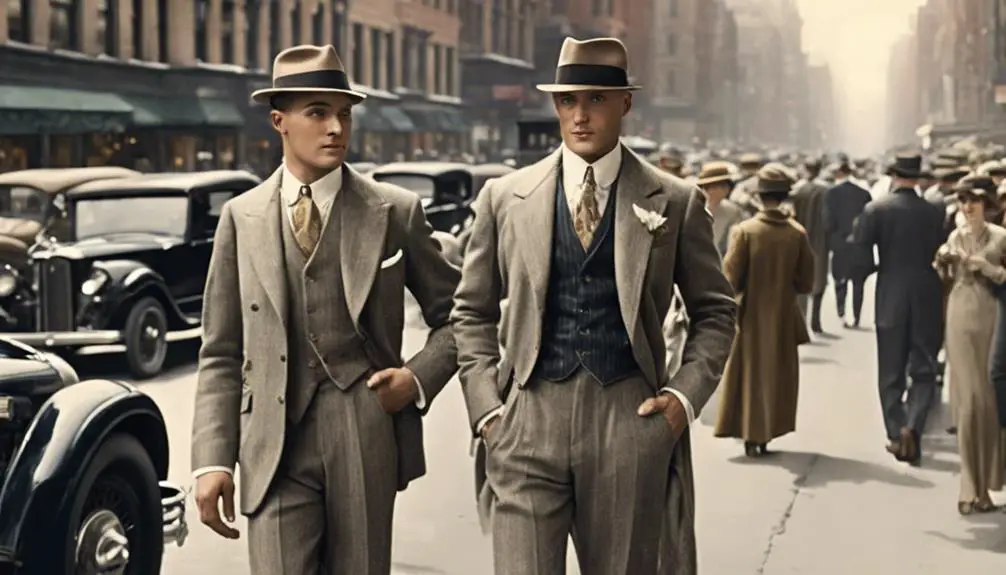
Suspenders, or braces as they're sometimes called, have a rich history that reflects changing fashion trends and societal norms. Initially, in the 19th century, suspenders served as the primary method of holding up trousers, symbolizing sophistication and elegance. Crafted from high-quality materials, they were a staple in men's wardrobes, embodying the fashion standards of the time.
By the 1920s, you'd notice a significant resurgence in the popularity of suspenders, especially with styles that complemented the retro classic look of the era. This period, often associated with the Great Gatsby aesthetic, highlighted suspenders as both functional and stylish. They effectively prevented trousers from sagging, allowing men to present themselves with confidence and flair.
The evolution of mens classic suspenders during this decade saw a shift in materials and designs. Elastic and cotton became increasingly common, with styles like Y-back and X-back gaining traction. This versatility not only enhanced comfort but also allowed individuals to express their unique taste. Overall, the history of men's suspenders reveals a fascinating interplay between practicality and fashion, marking their significance in the evolution of men's attire.
Popular Styles and Designs
The allure of 1920s men's fashion is unmistakably tied to the popular styles and designs of suspenders, which became a defining accessory of the era. Among the styles, the Y-back and Cotton X-Back suspenders stood out, with the Y-back favored for its sleek appearance and comfort. Clip-on versions gained traction, simplifying the attachment to trousers while maintaining a stylish edge.
Here's a closer look at some key characteristics of these iconic mens suspenders:
| Style | Description | Popular Features |
|---|---|---|
| Y-Back | Sleek design for comfort | Often made from elastic |
| Cotton X-Back | Classic and versatile | Soft and breathable fabric |
| Clip-On | Easy to attach | No need for button fastenings |
| Decorative | Jacquard patterns and designs | Adds sophistication |
Typically, suspenders measured around 3.5 cm in width, balancing functionality and style. The decorative elements, including intricate jacquard patterns, enhanced men's formal and semi-formal attire, making suspenders not just practical but also a statement piece. This era's suspenders captured the spirit of innovation and flair that defined the 1920s.
Materials Used in Suspenders
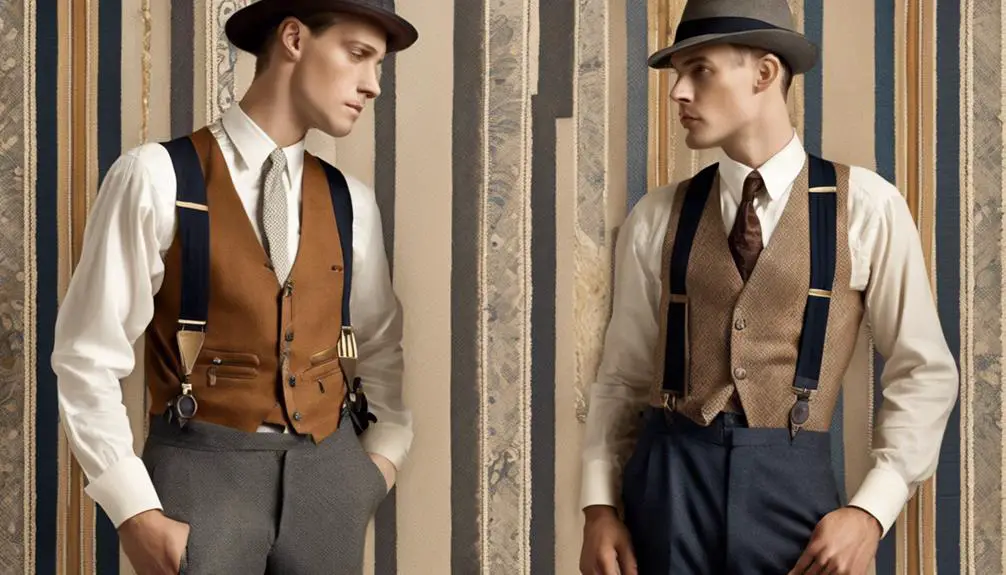
In the 1920s, a variety of materials transformed suspenders into not just functional accessories, but also style statements. Cotton suspenders emerged as a popular choice, prized for their durability and comfort. You'd find these practical options seamlessly fitting into everyday attire, ideal for the bustling lifestyle of the decade. Meanwhile, elastic suspenders gained traction for their flexibility, providing a snug fit that catered to the active man.
Silk suspenders, however, took the spotlight with their luxurious appearance, becoming synonymous with elegance. These sophisticated pieces often featured intricate patterns and jacquard weaves, reflecting the era's flair for stylish detail. Their rich texture added a touch of refinement to formal wear, making them sought-after for special occasions.
Leather also made a notable entrance in the world of suspenders, offering a chic alternative for formal events and weddings. Its classic look resonated with those wanting to make a statement. The combination of these materials not only guaranteed functionality but also allowed men to express their individuality, showcasing how suspenders evolved into essential components of 1920s fashion.
Cultural Significance in the 1920s
During the vibrant 1920s, suspenders emerged as more than mere functional garments; they became a hallmark of sophistication and a defining element of men's fashion. You'd notice that as the Jazz Age flourished, these trouser braces suspenders symbolized the elegance associated with the upper class and fashionable men. Their rise coincided with the decline of belts, which had turned more decorative than practical. Vintage clothing labels from this era often reflect the quality and style of suspenders, showcasing craftsmanship that resonates with collectors today.
In speakeasies and social gatherings, suspenders completed the 1920s retro look, allowing men to showcase both style and comfort. The era's emphasis on luxury fostered a transformation in the design and materials used, with silk and elastic becoming popular choices. This evolution reflected not just fashion trends but a cultural shift toward a more relaxed yet stylish demeanor.
As you explore contemporary fashion, it's fascinating to see how mens vintage suspenders continue to echo the style of the 1920s. Their lasting cultural significance speaks to a time when clothing choices carried deeper meanings, merging functionality with a statement of identity. Essentially, suspenders weren't just accessories; they were pivotal in defining a generation's aesthetic and social aspirations.
Notable Brands and Manufacturers
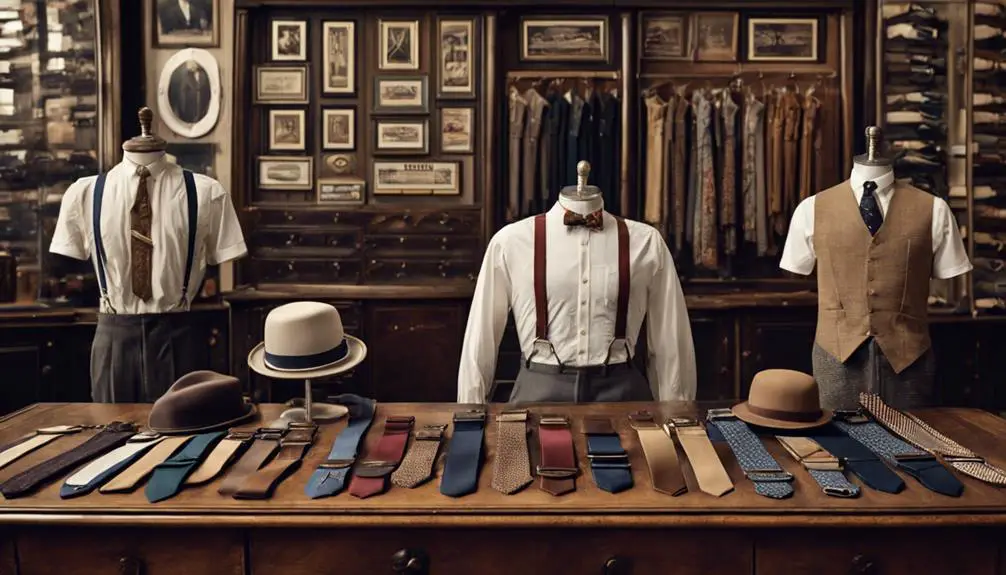
As the popularity of suspenders surged in the 1920s, several brands capitalized on this trend, each contributing to the era's distinctive style. Trafalgar emerged as a key player, renowned for its elegant silk braces that suited formal occasions perfectly. This focus on sophistication appealed to the fashionable elite of the decade. Similarly, HOLDEM specialized in high-quality silk suspenders, catering to the growing demand for luxurious men's accessories, and reflecting an era increasingly obsessed with style and status.
The Suspender Store became a popular retailer, offering a variety of styles, including jacquard and grosgrain suspenders that resonated with contemporary fashion trends. Meanwhile, brands like Dockers provided solid and reliable options, appealing to consumers who valued both practicality and style. Historical Emporium carved a niche by focusing on vintage-inspired suspenders, allowing customers to embrace the nostalgia of the 1920s while remaining stylish.
These notable brands not only shaped the suspenders market but also influenced consumer preferences, creating a legacy that intertwined functionality with fashion in a transformative decade.
Fashion Trends and Influence
Emerging from the cultural dynamism of the 1920s, suspenders became an essential accessory that seamlessly blended functionality with fashion. This decade marked a revival in men's fashion, where suspenders evolved into a staple for both formal and casual looks, embodying the era's elegance and sophistication. The popularity of suspenders can also be linked to the growing influence of brands like Betty Barclay, which captured the stylish essence of the time.
Typically available in Y-back or X-back designs, suspenders were crafted from luxurious materials like elastic, cotton, and silk. This not only elevated men's outfits but also distinguished suspenders as a stylish alternative to belts, which were often merely decorative. Pairing suspenders with high-waisted trousers and tailored suits enhanced the silhouette, allowing men to project sophistication while embracing comfort.
The influence of iconic works, such as The Great Gatsby, propelled these fashion trends, reviving vintage-inspired designs that resonate with modern consumers. Suspenders of the 1920s featured bold colors and patterns, enabling men to express their individuality within the confines of refined yet playful dressing. This period's fashion trends reflect a significant cultural shift, where personal expression and elegance coalesced, setting the stage for future interpretations of men's style.
Modern Revival and Usage
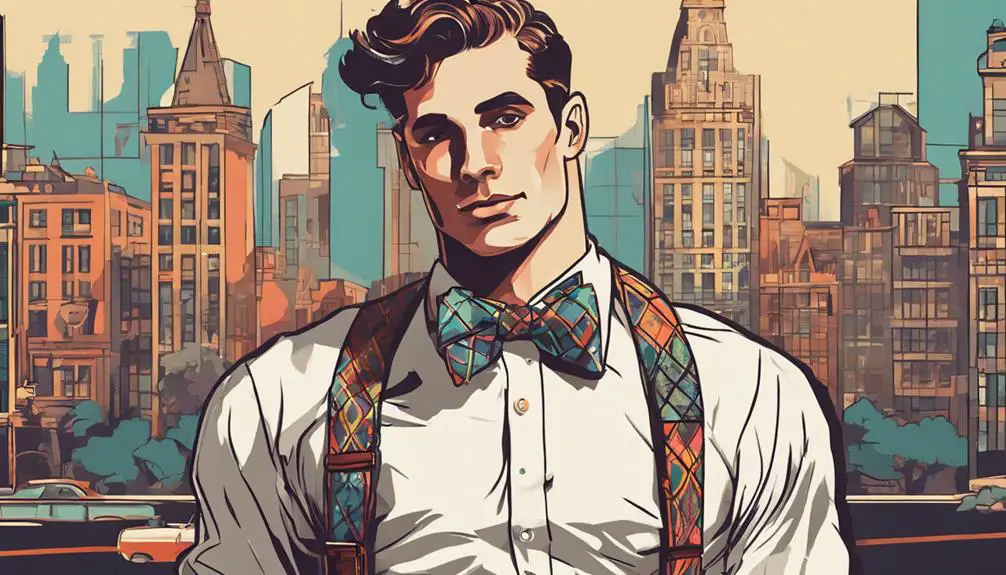
The resurgence of suspenders in modern fashion reflects a broader cultural fascination with vintage aesthetics, particularly those from the 1920s. These braces, often crafted from luxurious materials like silk and modern elastic, evoke a retro charm that appeals to both vintage enthusiasts and contemporary style seekers. As vintage fashion continues to thrive, knowing the importance of label identification can enhance your appreciation for these timeless pieces. You'll find suspenders becoming increasingly popular not just in casual settings but also at themed events celebrating the opulence of the Great Gatsby era.
Fashion icons and influencers are showcasing suspenders as versatile statement pieces, transforming them into must-have accessories for any wardrobe. The elastic Y-back design has become a favorite, offering both comfort and a sleek silhouette. This modern revival allows you to incorporate suspenders into your outfits easily, whether you're dressing up for a formal occasion or adding flair to your everyday wear.
As societal norms shift towards embracing unique fashion choices, suspenders have gained acceptance as stylish alternatives to belts, making them not just a nod to history but a bold fashion statement. By embracing these classic accessories, you're joining a movement that celebrates the charm and sophistication of the past while redefining contemporary style.
Frequently Asked Questions
Did Men Wear Suspenders in the 1920s?
Yes, men did wear suspenders in the 1920s. They provided a practical solution for sagging trousers while also symbolizing sophistication. Various styles emerged, allowing you to express personal flair in both formal and casual settings.
When Did Men Start Wearing Suspenders?
Men started wearing suspenders in the early 19th century, primarily to keep trousers up. Their practicality gained popularity, especially after the 1860s, as they effectively addressed sagging without relying on decorative belts.
What Did Men Typically Wear in the 1920s?
In the 1920s, you'd typically wear tailored suits with wide lapels, high-waisted trousers, and vibrant vests. Complementing your look, you'd add accessories like fedoras and pocket squares, finishing with polished leather shoes for sophistication.
What Decade Did Men Wear Suspenders?
Men typically wore suspenders prominently during the late 19th century and throughout the 20th century, especially in the 1920s. They served both practical and fashionable purposes, enhancing tailored looks while ensuring trousers stayed up.
